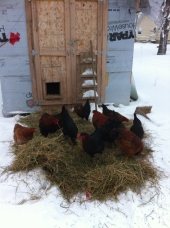
 11
11




Recommended reading material: Romans 10:9

 9
9




- Tim's Homestead Journal - Purchase a copy of Building a Better World in Your Backyard - Purchase 6 Decks of Permaculture Cards -
- Purchase 12x Decks of Permaculture Cards - Purchase a copy of the SKIP Book - Purchase 12x copies of Building a Better World in your Backyard
 9
9




"When the whole world is running towards a cliff, he who is running in the opposite direction appears to have lost his mind." C.S. Lewis
Visit https://themaineingredient.com for organic, premium dried culinary herbs that are grown, processed, and packaged in the USA.
 12
12




Visit Redhawk's soil series: https://permies.com/wiki/redhawk-soil
How permies.com works: https://permies.com/wiki/34193/permies-works-links-threads
 9
9




"The only thing...more expensive than education is ignorance."~Ben Franklin. "We can easily forgive a child who is afraid of the dark; the real tragedy of life is when men are afraid of the light." ~ Plato

 5
5




How Permies works: https://permies.com/wiki/34193/permies-works-links-threads
My projects on Skye: The tree field, Growing and landracing, perennial polycultures, "Don't dream it - be it! "
 7
7




Visit Redhawk's soil series: https://permies.com/wiki/redhawk-soil
How permies.com works: https://permies.com/wiki/34193/permies-works-links-threads
 7
7




Carla Burke wrote:......
I've come to look at them as little, feathered dinosaurs, who will occasionally turn on their own. Boredom buster ideas like Jay's are great .....
“The most important decision we make is whether we believe we live in a friendly or hostile universe.”― Albert Einstein







 6
6




Elanor Gardner wrote:Well I just completed chicken coop number 3. I suppose you may be wondering why I needed three coops. Well it's like this.
Elanor Gardner wrote:My rhode island reds are some feisty birds. They are not happy until they henpeck one of their flock to near death. We'll move the victim to a new coop, and a month or two later, they repeat the cycle with one of the remaining flock members. A week ago we tried to put the latest henpecking victim (we call her Miss Prissy) in with the first victim. (You would think they would be good friends seeing as they have a near death experience in common.) Only now Victim 1 (we also call her Miss Prissy) has regained her strength, and is feisty, and wants to kill the latest henpecked victim. Hence, the third coop. I put it inside the run of the second coop. Hopefully they will look at each other for a week or so, and get used to each to each other and then I can remove the third coop. (Hopefully, meaning before winter...) The third coop was built of scraps but is sturdy and safe. It was extremely hard to build as I am on day three of a nasty virus myself, and probably should have been resting. Oh well.
Elanor Gardner wrote:Buy cinnamon queens, because rhode island reds are simply too feisty. That is really the moral of the story.
There is nothing so bad that politics cannot make it worse. - Thomas Sowell
Everything that is really great and inspiring is created by the individual who can labor in freedom. - Albert Einstein
 7
7




Recommended reading material: Romans 10:9
 6
6




Elanor Gardner wrote:...who refused to stay in my yard, would go to the neighbors and lay eggs in a burdock patch at the neighbors every day, and so I made the decision to keep them in their house and chicken run.
"The only thing...more expensive than education is ignorance."~Ben Franklin. "We can easily forgive a child who is afraid of the dark; the real tragedy of life is when men are afraid of the light." ~ Plato
 2
2




Invasive plants are Earth's way of insisting we notice her medicines. Stephen Herrod Buhner
Everyone learns what works by learning what doesn't work. Stephen Herrod Buhner







 7
7




There is nothing so bad that politics cannot make it worse. - Thomas Sowell
Everything that is really great and inspiring is created by the individual who can labor in freedom. - Albert Einstein







